Paper Menu >>
Journal Menu >>
 J. Modern Physics, 2010, 1, 100-107 doi:10.4236/jmp.2010.12015 Published Online June 2010 (http://www.SciRP.org/journal/jmp) Copyright © 2010 SciRes. JMP A Second-Order Eigen Theory for Static Electromagnetic Fields Shaohua Guo School of Civil Engineering and Architecture, Zhejiang University of Science and Technology, Hangzhou, China Email: gsh606@yahoo.com.cn Received March 28th, 2010; revised May 1st, 2010; accepted May 20th, 2010 Abstract The static electromagnetic fields are studied here based on the standard spaces of the physical presentation, and the modal equations of static electromagnetic fields for anisotropic media are deduced. By introducing a set of new poten- tial functions of order 2, several novel theoretical results were obtained: The classical potential functions of order 1 can be expressed by the new potential functions of order 2, the electric or magnetic potentials are scalar for isotropic media, and vector for anisotropic media. The amplitude and direction of the vector potentials are related to the anisot- ropic subspaces. Based on these results, we discuss the laws of static electromagnetic fields for anisotropic media. Keywords: Anisotropic Media, Static Electromagnetic Field, Standard Spaces, Modal Equation Formatting 1. Introduction By the Maxwell’s electromagnetic field equations, we know that the electric and magnetic field are independent each other under the condition of static fields. The clas- sical electromagnetic field theory also believes that the static electric field can be described by a scalar potential function, and the magnetic field by a vector one. Fur- thermore, for the passive region, the magnetic field can also be described by a scalar potential function [1,2]. But it should be pointed out that these results can only be obtained in the condition of isotropy, and are also only suit for the isotropic media. However, with the develop- ment of material science, more and more anisotropic dielectric or magnetic materials are applied to various fields, such as electron devices, communications and sensors, even for the traditional geological structure, we also can see the electrically anisotropic media or mag- netically anisotropic media. It is found by recent re- search works that the limitations of classical static elec- tromagnetic field theory have become obvious for these anisotropic media. For example, the above results for isotropic media don’t exist for anisotropic media, even we don’t know the definite form of the electric field po- tential function or magnetic field potential function, which make a great difficulty in solving the problem of anisotropic static electric or magnetic fields [3-5]. Unlike the classical static electromagnetic field theory, which studies the Maxwell’s equations under the geometric representation, in this paper, the Maxwell’s equations are restudied under the physical representation. As the result of this, the modal equations of static electric or magnetic fields are deduced, which give the novel expressions for the potential functions of static electric or magnetic fields for anisotropic media, and bring to light the intrin- sic laws of static electromagnetic field. 2. Standard Spaces of Electromagnetic Media In anisotropic electromagnetic media, the dielectric per- mittivity and magnetic permeability are tensors instead of scalars. The constitutive relations are expressed as follows D E (1) B H (2) where the dielectric permittivity matrix and the magnetic permeability matrix are usually symmetric ones, and the elements of the matrixes have a close rela- tionship with the selection of reference coordinate. Sup- pose that if the reference coordinates is selected along principal axis of electrically or magnetically anisotropic media, the elements at non-diagonal of these matrixes turn to be zero. Therefore, Equations (1) and (2) are called the constitutive equations of electromagnetic media un- der the geometric presentation. Now we intend to get rid of effects of geometric coordinate on the constitutive  A Second-Order Eigen Theory for Static Electromagnetic Fields Copyright © 2010 SciRes. JMP 101 equations, and establish a set of coordinate-independent constitutive equations of electromagnetic media under physical presentation. For this purpose, we solve the fol- lowing problems of eigen-value of matrixes -0Ij (3) -0I (4) where 1, 2, 3 ii and 1, 2, 3 i gi are respectively eigen dielectric permittivity and eigen magnetic perme- ability, which are constants of coordinate-independent. 1, 2, 3 i ji and 1, 2, 3 ii are respectively eigen electric vector and eigen magnetic vector, which show the electrically principal direction and magnetically prin- cipal direction of anisotropic media, and are all coordi- nate-dependent. We call these vectors as standard spaces. Thus, the matrix of dielectric permittivity and magnetic permeability can be spectrally decomposed as follows (5) (6) where 123 ,,diag and 123 ,,diag are the matrix of eigen dielectric permittivity and eigen magnetic permeability, respectively. 123 ,,jjj and 123 ,, are respectively the modal matrix of electric media and magnetic media, which are both or- thogonal and positive definite ones, and satisfy T I ,T I . Projecting the electromagnetic physical qualities of the geometric presentation, such as the electric field intensity vector E, magnetic field intensity vector H , magnetic flux density vectorB and electric displacement vec- tor D, into the standard spaces of the physical presenta- tion, we get *1, 2, 3 ii DjDi (7) *1, 2, 3 ii EjEi (8) *1, 2, 3 ii BBi (9) *1, 2,3 ii HHi (10) These are the electromagnetic physical qualities under the physical presentation. Substituting Equations (7)-(10) into Equations (1) and (2) respectively, and using Equations (5) and (6) yield, we have ** DE (11) ** BH (12) or ** 1, 2, 3 iii DEi (13) ** 1, 2, 3 iii BHi (14) The above equations are just the modal constitutive equations in the form of scalar. 3. Matrix form of Static Electromagnetic Field Equation The classical static Maxwell’s equations in passive re- gion can be written as =0, =0ED (15) =0, =0 H B (16) where is a Hamilton operator. It is seen from the above equations that the electric field and magnetic field are not only independent, but also the same in the form of equation. So, it is undistinguishable to study the prob- lems of electric field or magnetic field under the static condition. For this purpose, we consider here only the problem of electric field. From Equation (15), we can see that one is a vector equation, another is scalar one. It is well known that the vector equation can be written as the matrix one, but the scalar equation can not. By the first one of Equation (15), we have 0E (17) where 0 0 0 z y z x yx (18) It is an operator matrix of order 1. In order get the matrix expression of static electromag- netic equations, both of Equation (15) should be re- formed in a suitable form. For dynamic electromagnetic fields, a matrix equation of electromagnetic waves be dedued by author [6] 2 t EE (19) where z zyy xyxz yxxx zzyz zx zyxx yy (20) It is an operator matrix of order 2. For static electro- mag-netic fields, we have 0E (21) Now, rewriting the second one of Equation (15) in the 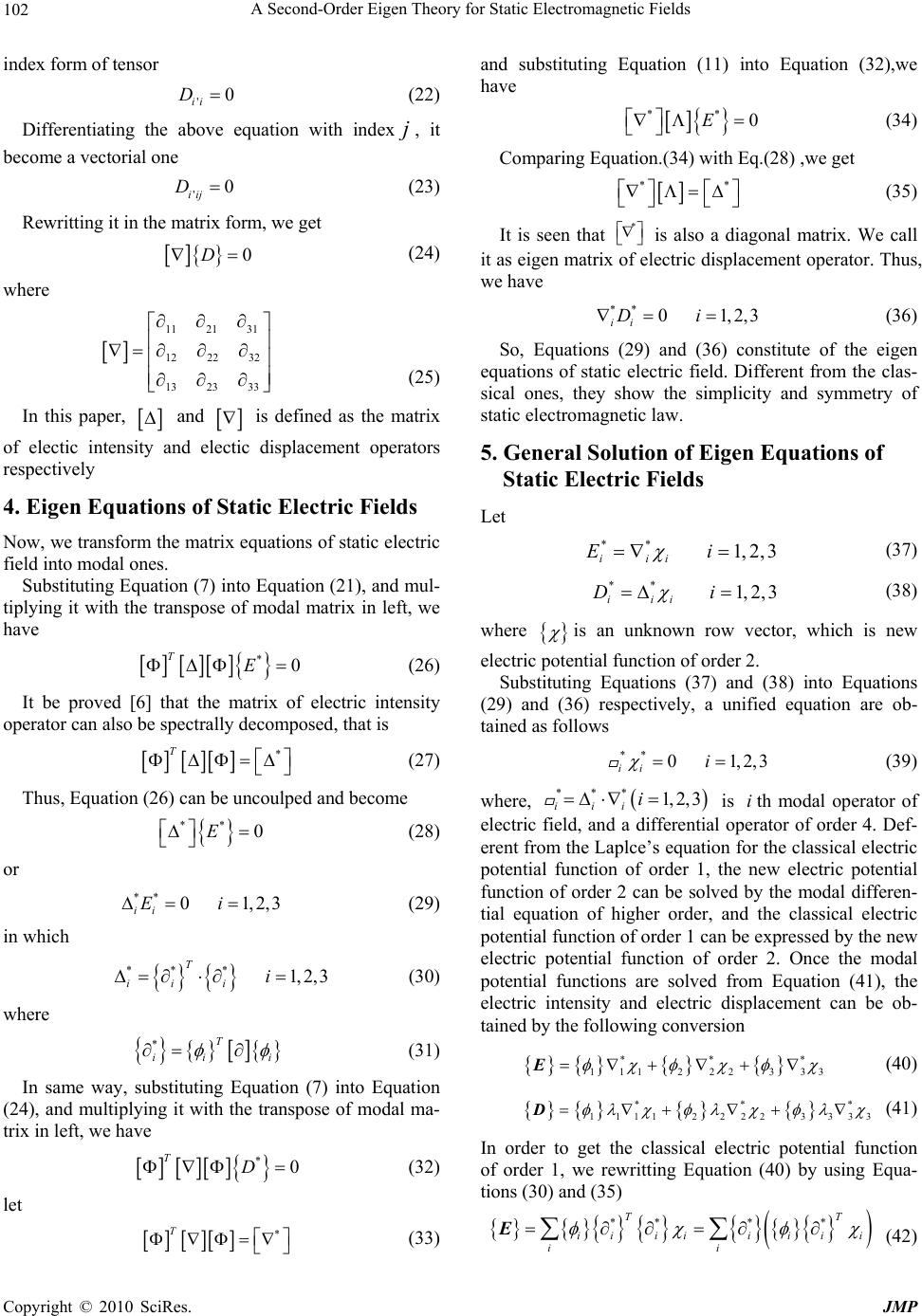 A Second-Order Eigen Theory for Static Electromagnetic Fields Copyright © 2010 SciRes. JMP 102 index form of tensor '0 ii D (22) Differentiating the above equation with index j , it become a vectorial one '0 iij D (23) Rewritting it in the matrix form, we get 0D (24) where 11 21 31 12 22 32 13 2333 (25) In this paper, and is defined as the matrix of electic intensity and electic displacement operators respectively 4. Eigen Equations of Static Electric Fields Now, we transform the matrix equations of static electric field into modal ones. Substituting Equation (7) into Equation (21), and mul- tiplying it with the transpose of modal matrix in left, we have *0 TE (26) It be proved [6] that the matrix of electric intensity operator can also be spectrally decomposed, that is * T (27) Thus, Equation (26) can be uncoulped and become ** 0E (28) or ** 01,2,3 ii Ei (29) in which ** *1, 2, 3 T ii i i (30) where *T ii i (31) In same way, substituting Equation (7) into Equation (24), and multiplying it with the transpose of modal ma- trix in left, we have *0 TD (32) let * T (33) and substituting Equation (11) into Equation (32),we have ** 0E (34) Comparing Equation.(34) with Eq.(28) ,we get ** (35) It is seen that * is also a diagonal matrix. We call it as eigen matrix of electric displacement operator. Thus, we have ** 01,2,3 ii Di (36) So, Equations (29) and (36) constitute of the eigen equations of static electric field. Different from the clas- sical ones, they show the simplicity and symmetry of static electromagnetic law. 5. General Solution of Eigen Equations of Static Electric Fields Let ** 1,2, 3 iii Ei (37) ** 1, 2, 3 iii Di (38) where is an unknown row vector, which is new electric potential function of order 2. Substituting Equations (37) and (38) into Equations (29) and (36) respectively, a unified equation are ob- tained as follows ** 01,2,3 ii i (39) where, *** 1,2, 3 iii i is ith modal operator of electric field, and a differential operator of order 4. Def- erent from the Laplce’s equation for the classical electric potential function of order 1, the new electric potential function of order 2 can be solved by the modal differen- tial equation of higher order, and the classical electric potential function of order 1 can be expressed by the new electric potential function of order 2. Once the modal potential functions are solved from Equation (41), the electric intensity and electric displacement can be ob- tained by the following conversion ** * 1112223 33 E (40) ** * 11112 2223 333 D (41) In order to get the classical electric potential function of order 1, we rewritting Equation (40) by using Equa- tions (30) and (35) *** * TT iiiii ii i ii E (42) 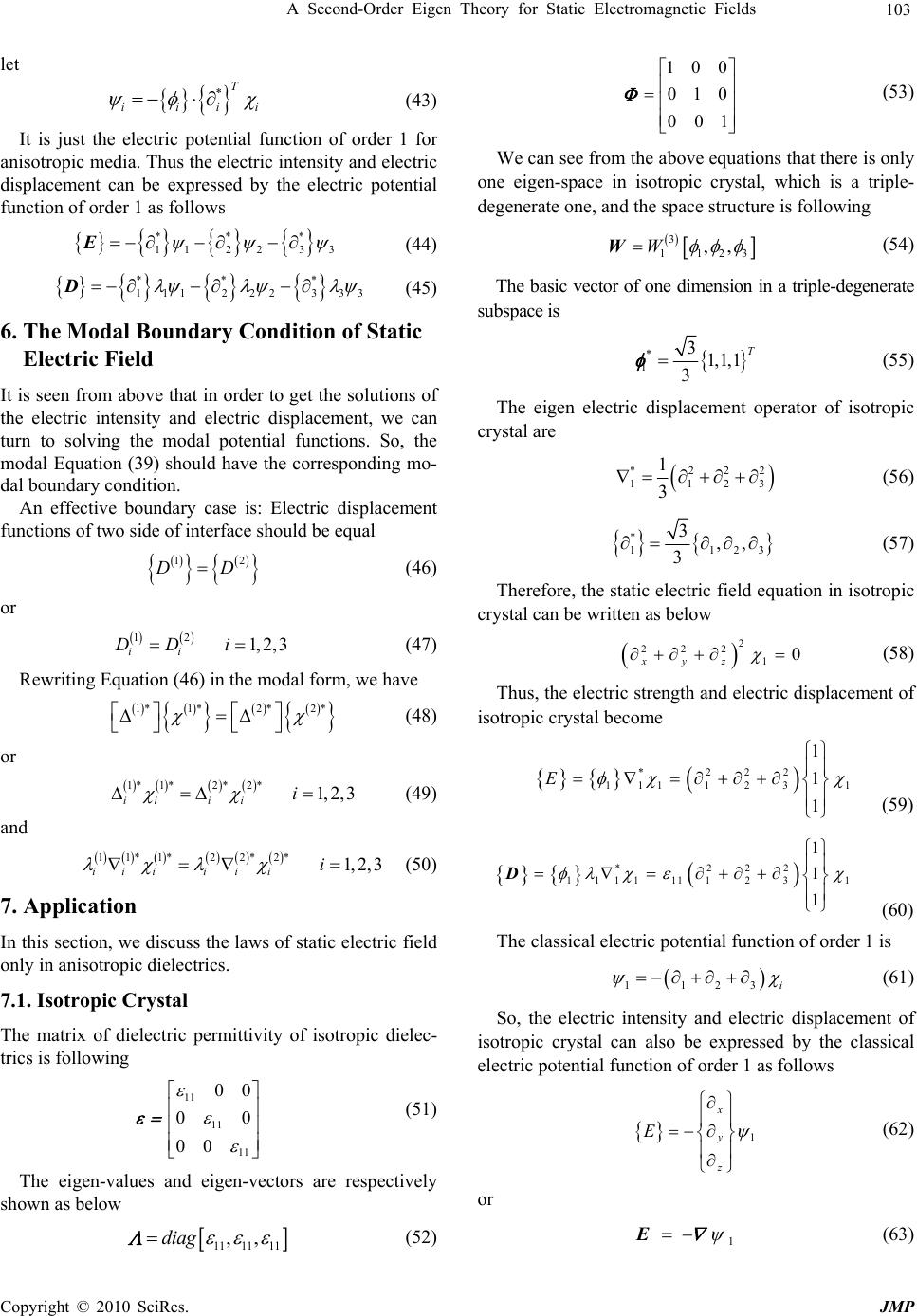 A Second-Order Eigen Theory for Static Electromagnetic Fields Copyright © 2010 SciRes. JMP 103 let *T iiii (43) It is just the electric potential function of order 1 for anisotropic media. Thus the electric intensity and electric displacement can be expressed by the electric potential function of order 1 as follows ** * 11 22 33 E (44) ** * 111 222333 D (45) 6. The Modal Boundary Condition of Static Electric Field It is seen from above that in order to get the solutions of the electric intensity and electric displacement, we can turn to solving the modal potential functions. So, the modal Equation (39) should have the corresponding mo- dal boundary condition. An effective boundary case is: Electric displacement functions of two side of interface should be equal 12 DD (46) or 12 1, 2, 3 ii DD i (47) Rewriting Equation (46) in the modal form, we have 1* 1*2*2* (48) or 1* 1*2*2*1, 2, 3 iiiii (49) and 11*1*22*2*1, 2, 3 ii ii iii (50) 7. Application In this section, we discuss the laws of static electric field only in anisotropic dielectrics. 7.1. Isotropic Crystal The matrix of dielectric permittivity of isotropic dielec- trics is following 00 00 00 (51) The eigen-values and eigen-vectors are respectively shown as below 11 11 11 ,,diag (52) 100 010 001 (53) We can see from the above equations that there is only one eigen-space in isotropic crystal, which is a triple- degenerate one, and the space structure is following 3 1123 ,,W W (54) The basic vector of one dimension in a triple-degenerate subspace is * 1 31,1,1 3 T (55) The eigen electric displacement operator of isotropic crystal are * 222 1123 1 3 (56) * 1123 3,, 3 (57) Therefore, the static electric field equation in isotropic crystal can be written as below 2 222 10 xyz (58) Thus, the electric strength and electric displacement of isotropic crystal become *222 1111231 1 1 1 E (59) * 222 11111112 31 1 1 1 D (60) The classical electric potential function of order 1 is 1123i (61) So, the electric intensity and electric displacement of isotropic crystal can also be expressed by the classical electric potential function of order 1 as follows 1 x y z E (62) or 1 E (63) 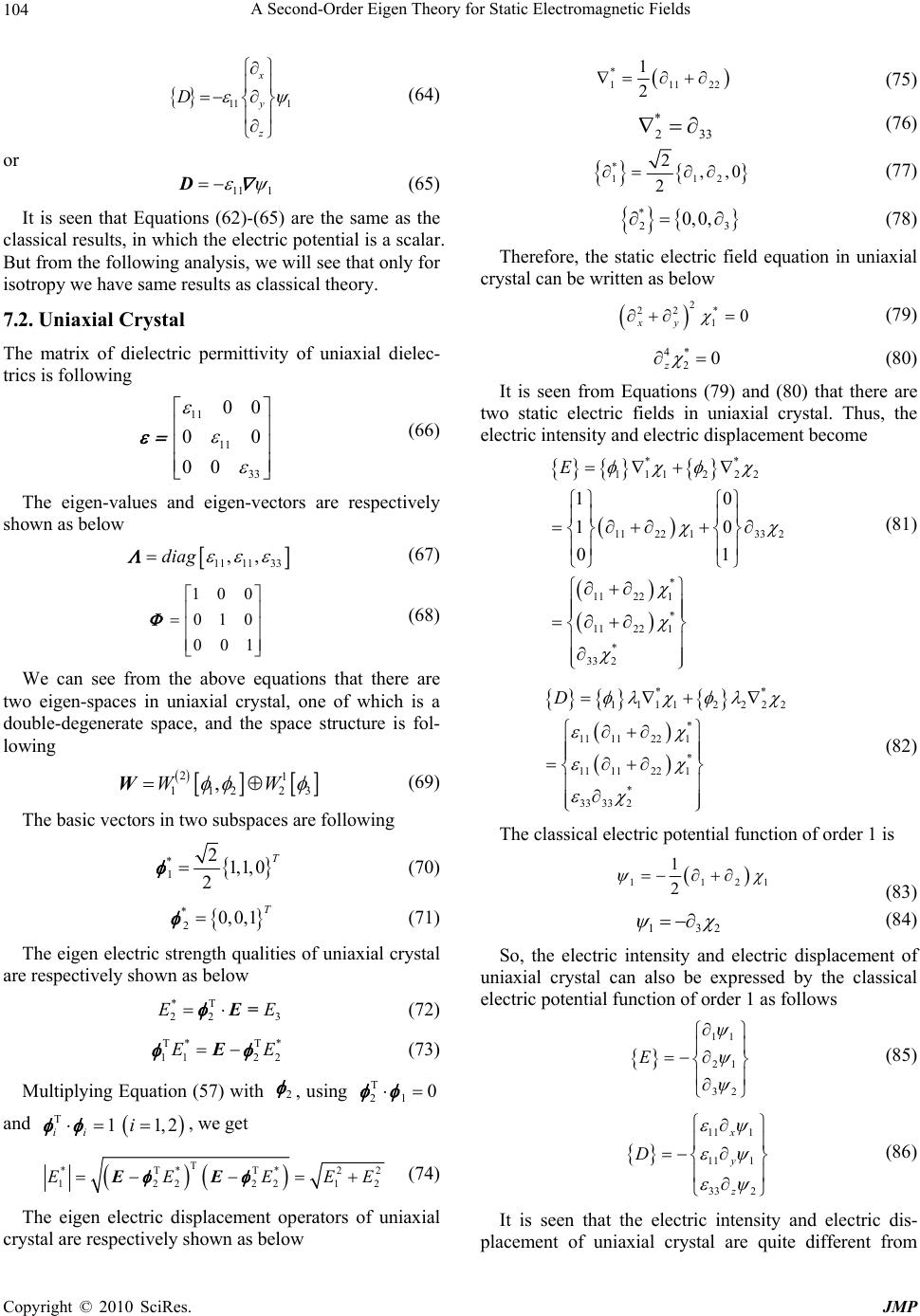 A Second-Order Eigen Theory for Static Electromagnetic Fields Copyright © 2010 SciRes. JMP 104 11 1 x y z D (64) or 11 1 D (65) It is seen that Equations (62)-(65) are the same as the classical results, in which the electric potential is a scalar. But from the following analysis, we will see that only for isotropy we have same results as classical theory. 7.2. Uniaxial Crystal The matrix of dielectric permittivity of uniaxial dielec- trics is following 11 11 33 00 00 00 (66) The eigen-values and eigen-vectors are respectively shown as below 11 1133 ,,diag (67) 100 010 001 (68) We can see from the above equations that there are two eigen-spaces in uniaxial crystal, one of which is a double-degenerate space, and the space structure is fol- lowing 21 112 23 ,WW W (69) The basic vectors in two subspaces are following * 1 21, 1,0 2 T (70) * 20, 0,1T (71) The eigen electric strength qualities of uniaxial crystal are respectively shown as below *T 22 3 EE E = (72) T* T* 11 22 EE E (73) Multiplying Equation (57) with 2 , using T 21 0 and T11,2 ii i , we get T *T*T*22 1222212 E EEEEEE (74) The eigen electric displacement operators of uniaxial crystal are respectively shown as below * 11122 1 2 (75) * 233 (76) * 112 2,,0 2 (77) * 23 0, 0, (78) Therefore, the static electric field equation in uniaxial crystal can be written as below 2 22 * 10 xy (79) 4* 20 z (80) It is seen from Equations (79) and (80) that there are two static electric fields in uniaxial crystal. Thus, the electric intensity and electric displacement become ** 1112 22 1122133 2 * 1122 1 * 1122 1 * 33 2 10 10 01 E (81) ** 11112222 * 11 11221 * 11 11221 * 33 332 D (82) The classical electric potential function of order 1 is 1121 1 2 (83) 132 (84) So, the electric intensity and electric displacement of uniaxial crystal can also be expressed by the classical electric potential function of order 1 as follows 11 21 32 E (85) 11 1 11 1 33 2 x y z D (86) It is seen that the electric intensity and electric dis- placement of uniaxial crystal are quite different from  A Second-Order Eigen Theory for Static Electromagnetic Fields Copyright © 2010 SciRes. JMP 105 those in isotropic crystal, and there exist two kinds of modal electric potential functions in uniaxial crystal, so they become vectorial ones, this is also different from the classical results of static electric field. 7.3. Biaxial Crystal The matrix of dielectric permittivity of biaxial dielectrics is following 11 22 33 00 00 00 (87) The eigen-values and eigen-vectors are respectively shown as below 11 2233 ,,diag (88) 100 010 001 (89) We can see from the above equations that there are three eigen-spaces in biaxial crystal, and the space struc- ture is following 11 1 1122 33 WWW W (90) The eigen-qualities and eigen electric displacement operators of biaxial crystal are respectively shown as below *T 11 1 EE E = (91) *T 22 2 EE E = (92) *T 333 EE E = (93) ** 111 1 1 ,0,0T (94) ** 222 22 0,, 0T (95) ** 333 33 0, 0,T (96) Therefore, the static electric field equation in biaxial crystal can be written as below 4* 10 x (97) 4* 20 y (98) 4* 30 z (99) It is seen from Equations (97)-(99) that there are three static electric fields in biaxial crystal. Thus, the electric intensity and electric displacement become ** * 1112 22333 ** * 11 22 33 11 1 22 2 33 3 100 01 0 001 E (100) 11 111 22 222 33 333z D (101) The classical electric potential function of order 1 is 111 (102) 222 (103) 332 (104) So, the electric intensity and electric displacement of uniaxial crystal can also be expressed by the classical electric potential function of order 1 as follows 11 22 33 E (105) 11 1 22 2 33 3 x y z D (106) It is seen that the electric intensity and electric dis- placement of biaxial crystal are quite different from those in isotropic crystal, and there exist three kinds of modal electric potential functions in uniaxial crystal, so they become vectorial ones, this is also different from the classical results of static electric field. 7.4. Monoclinic Crystal The matrix of dielectric permittivity of monoclinic di- electrics is following 11 12 12 22 33 0 0 00 (107) The eigen-values and eigen-vectors are respectively shown as below 1233 ,,diag (108) 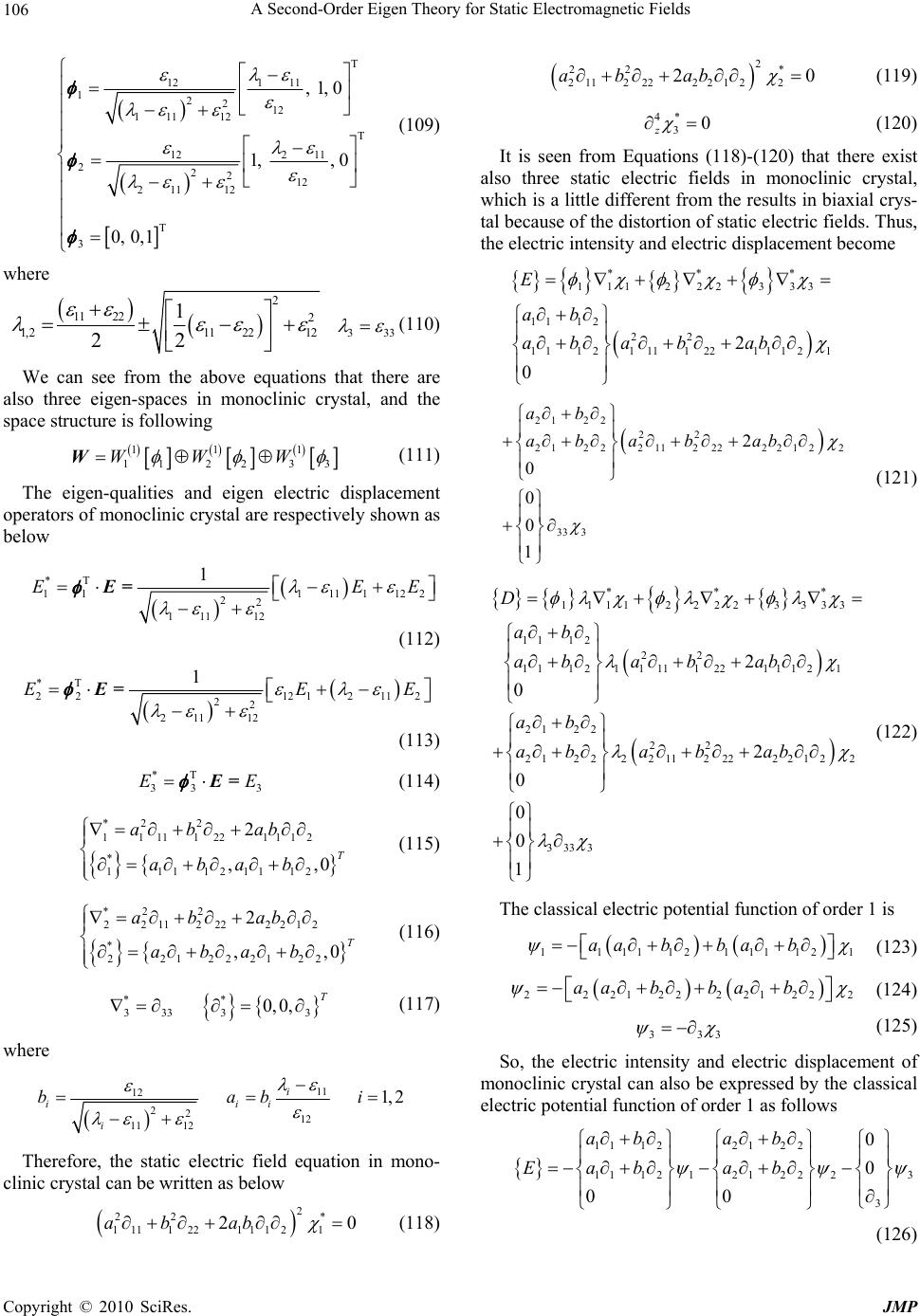 A Second-Order Eigen Theory for Static Electromagnetic Fields Copyright © 2010 SciRes. JMP 106 T 121 11 2212 11112 T 122 11 2212 211 12 T ,1,0 1,, 0 0, 0,1 (109) where 2 11 222 1, 2112212 1 22 333 (110) We can see from the above equations that there are also three eigen-spaces in monoclinic crystal, and the space structure is following 11 1 1122 33 WWW W (111) The eigen-qualities and eigen electric displacement operators of monoclinic crystal are respectively shown as below *T 11 1111122 22 11112 1 EEE E= (112) *T 2212 12112 22 211 12 1 EEE E= (113) *T 33 3 EE E = (114) *2 2 1111122 1112 * 1 11121112 2 ,,0 T ab ab abab (115) *22 2211222 2212 * 2 21222122 2 ,,0 T ab ab abab (116) ** 333 33 0, 0,T (117) where 11 12 2212 11 12 1, 2 i iii i babi Therefore, the static electric field equation in mono- clinic crystal can be written as below 2 22 * 1111 2211121 20ab ab (118) 2 22 * 2112 2222122 20ab ab (119) 4* 30 z (120) It is seen from Equations (118)-(120) that there exist also three static electric fields in monoclinic crystal, which is a little different from the results in biaxial crys- tal because of the distortion of static electric fields. Thus, the electric intensity and electric displacement become *** 1112223 33 111 2 22 11121 1112211121 2 0 E ab ab abab 21 22 22 21222112 2222122 33 3 2 0 0 0 1 ab ab abab (121) *** 11112 2223 333 111 2 22 11 121111 12211121 21 22 22 212222112 2222122 3333 2 0 2 0 0 0 1 D ab aba bab ab aba bab (122) The classical electric potential function of order 1 is 111112111121 aa bba b (123) 222122221222 aa bbab (124) 333 (125) So, the electric intensity and electric displacement of monoclinic crystal can also be expressed by the classical electric potential function of order 1 as follows 111 22122 111 212 12 223 3 0 0 00 aba b Eabab (126) 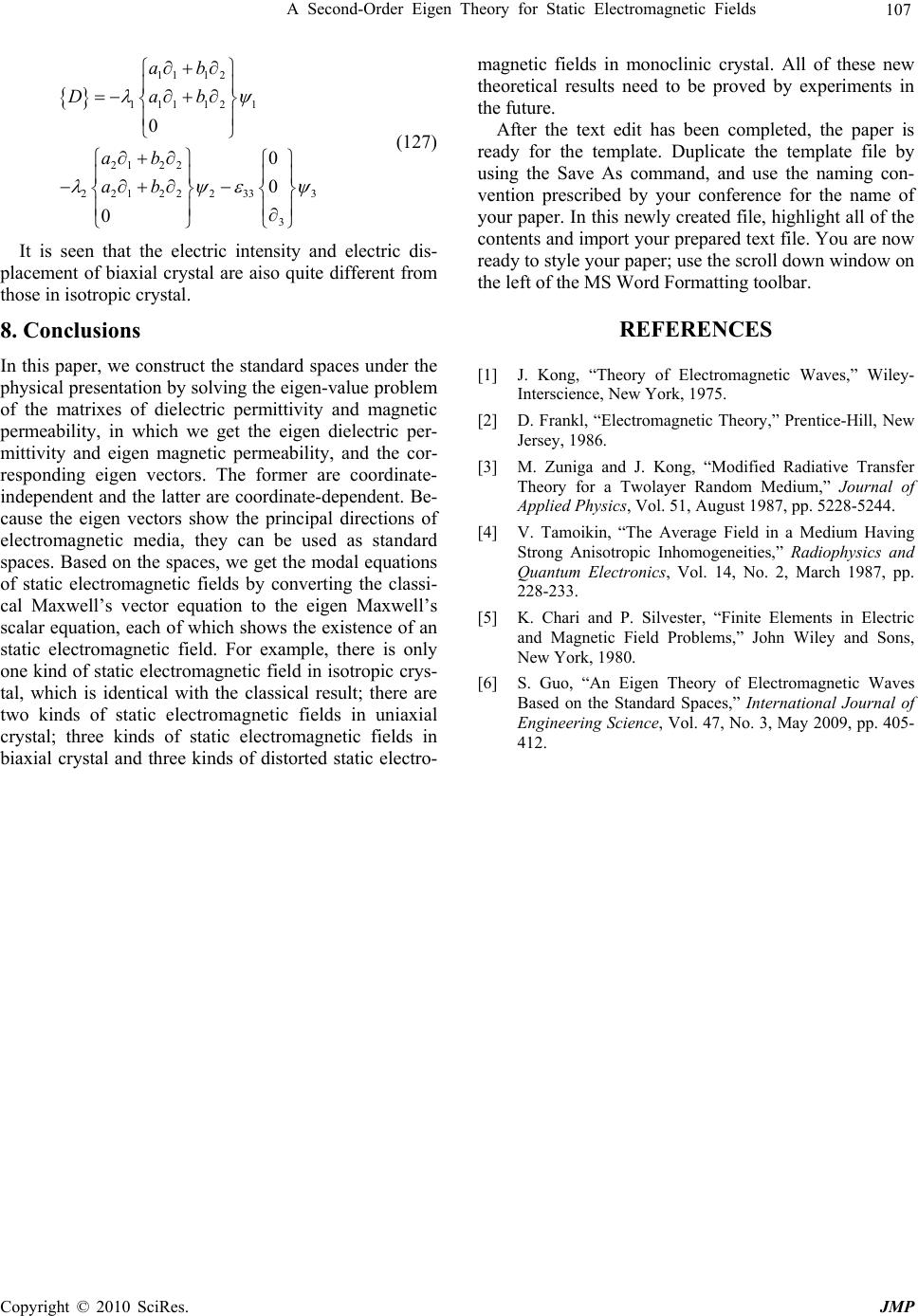 A Second-Order Eigen Theory for Static Electromagnetic Fields Copyright © 2010 SciRes. JMP 107 11 12 11112 1 21 22 221222333 3 0 0 0 0 ab Dab ab ab (127) It is seen that the electric intensity and electric dis- placement of biaxial crystal are aiso quite different from those in isotropic crystal. 8. Conclusions In this paper, we construct the standard spaces under the physical presentation by solving the eigen-value problem of the matrixes of dielectric permittivity and magnetic permeability, in which we get the eigen dielectric per- mittivity and eigen magnetic permeability, and the cor- responding eigen vectors. The former are coordinate- independent and the latter are coordinate-dependent. Be- cause the eigen vectors show the principal directions of electromagnetic media, they can be used as standard spaces. Based on the spaces, we get the modal equations of static electromagnetic fields by converting the classi- cal Maxwell’s vector equation to the eigen Maxwell’s scalar equation, each of which shows the existence of an static electromagnetic field. For example, there is only one kind of static electromagnetic field in isotropic crys- tal, which is identical with the classical result; there are two kinds of static electromagnetic fields in uniaxial crystal; three kinds of static electromagnetic fields in biaxial crystal and three kinds of distorted static electro- magnetic fields in monoclinic crystal. All of these new theoretical results need to be proved by experiments in the future. After the text edit has been completed, the paper is ready for the template. Duplicate the template file by using the Save As command, and use the naming con- vention prescribed by your conference for the name of your paper. In this newly created file, highlight all of the contents and import your prepared text file. You are now ready to style your paper; use the scroll down window on the left of the MS Word Formatting toolbar. REFERENCES [1] J. Kong, “Theory of Electromagnetic Waves,” Wiley- Interscience, New York, 1975. [2] D. Frankl, “Electromagnetic Theory,” Prentice-Hill, New Jersey, 1986. [3] M. Zuniga and J. Kong, “Modified Radiative Transfer Theory for a Twolayer Random Medium,” Journal of Applied Physics, Vol. 51, August 1987, pp. 5228-5244. [4] V. Tamoikin, “The Average Field in a Medium Having Strong Anisotropic Inhomogeneities,” Radiophysics and Quantum Electronics, Vol. 14, No. 2, March 1987, pp. 228-233. [5] K. Chari and P. Silvester, “Finite Elements in Electric and Magnetic Field Problems,” John Wiley and Sons, New York, 1980. [6] S. Guo, “An Eigen Theory of Electromagnetic Waves Based on the Standard Spaces,” International Journal of Engineering Science, Vol. 47, No. 3, May 2009, pp. 405- 412. |

